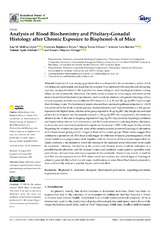Mostrar el registro sencillo del ítem
Analysis of Blood Biochemistry and Pituitary-Gonadal Histology after Chronic Exposure to Bisphenol-A of Mice
| dc.contributor.author | Molina López, Ana María | |
| dc.contributor.author | Bujalance Reyes, Francisca | |
| dc.contributor.author | Urbano, María Teresa | |
| dc.contributor.author | Lora Benítez, Antonio | |
| dc.contributor.author | Ayala Soldado, Nahúm | |
| dc.contributor.author | Moyano-Salvag, Rosario | |
| dc.date.accessioned | 2022-10-27T07:18:02Z | |
| dc.date.available | 2022-10-27T07:18:02Z | |
| dc.date.issued | 2022 | |
| dc.identifier.uri | http://hdl.handle.net/10396/24227 | |
| dc.description.abstract | Bisphenol-A is an emerging pollutant that is widespread in the environment, and to which live beings are continuously and inadvertently exposed. It is a substance with an endocrine-disrupting capacity, causing alterations in the reproductive, immunological, and neurological systems, among others, as well as metabolic alterations. Our study aimed to assess its clinical signs, and effects on the most relevant blood biochemical parameters, and to evaluate pituitary and gonadal histology after a chronic exposure of adult mice to different BPA doses (0.5, 2, 4, 50 and 100 µg/kg BW/day) through their drinking water. The biochemical results showed that a marked significant reduction (p < 0.05) was produced in the levels of serum glucose, hypoproteinaemia and hypoalbuminemia in the groups exposed to the highest doses, whereas in the group exposed to 50 µg/kg BW/day the glucose and total protein levels dropped, and the animals exposed to 100 µg/kg BW/day experienced a diminution in albumin levels. In the case of the group exposed to 50 µg/kg BW/day, however, hypertriglyceridemia and hypercholesterolemia were determined, and the blood parameters indicating kidney alterations such as urea and creatinine experienced a significant increase (p < 0.05) with respect to the controls. Regarding the pituitary and gonads, none of the animals exposed presented histological alterations at the doses tested, giving similar images to those of the control group. These results suggest that continuous exposure to low BPA doses could trigger an inhibition of hepatic gluconeogenesis, which would result in a hypoglycaemic state, together with an induction of the enzymes responsible for lipidic synthesis, a mechanism by which the increase in the lipid and serum cholesterol levels could be explained. Likewise, the decline in the protein and albumin levels would be indicative of a possible hepatic alteration, and the increase in urea and creatinine would point to a possible renal perturbation, derived from continuous exposure to this xenobiotic. Based on our results, it could be said that chronic exposure to low BPA doses would not produce any clinical signs or histological pituitary-gonadal effects, but it could cause modifications in some blood biochemical parameters, that could initially indicate a possible hepatic and renal effect. | es_ES |
| dc.format.mimetype | application/pdf | es_ES |
| dc.language.iso | eng | es_ES |
| dc.publisher | MDPI | es_ES |
| dc.rights | https://creativecommons.org/licenses/by/4.0/ | es_ES |
| dc.source | International Journal of Environmental Research and Public Health, 19(21), 13894 (2022) | es_ES |
| dc.subject | Bispheno-A | es_ES |
| dc.subject | Endocrine disruptor | es_ES |
| dc.subject | Biochemical parameters | es_ES |
| dc.subject | Hypertriglyceridemia | es_ES |
| dc.subject | Hypercholesterolemia | es_ES |
| dc.title | Analysis of Blood Biochemistry and Pituitary-Gonadal Histology after Chronic Exposure to Bisphenol-A of Mice | es_ES |
| dc.type | info:eu-repo/semantics/article | es_ES |
| dc.relation.publisherversion | https://doi.org/10.3390/ijerph192113894 | es_ES |
| dc.relation.projectID | Junta de Andalucia. 381098-R (FEDER) | es_ES |
| dc.rights.accessRights | info:eu-repo/semantics/openAccess | es_ES |

